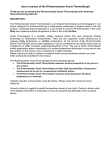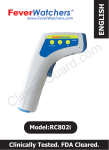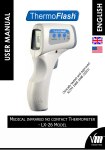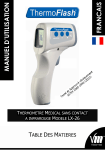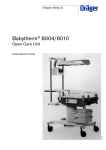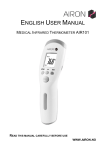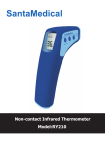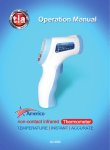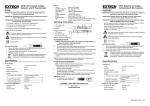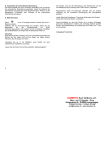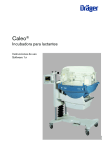Download IR-Thermometer Smart ThermoGraph User Manual
Transcript
IR-Thermometer Smart ThermoGraph User Manual Thank you for purchasing the IR-thermometer Smart ThermoGraph with advanced thermo-monitoring features. Introduction The IR-thermometer Smart ThermoGraph is an infrared thermometer and thermograph in one device designed for thermo-monitoring of inflammatory sicknesses of organs close to the skin surface. It measures body temperature in a way similar to common IRthermometers in Body mode and measures the skin surface temperature in Surface mode. Smart Thermograph is a portable, battery-powered device that uses advanced infrared technology for temperature measurement. Smart Thermograph has two supported modes that allow you to measure body temperature or surface temperature. You can measure surface temperature using just the IR-thermometer Smart ThermoGraph or you can connect it to any mobile device, such as smartphone or tablet computer that supports Bluetooth 4.0 LE. Using Smart ThermoGraph mobile applications allows you to see the surface temperature distribution of any area of your skin surface on the screen of your smartphone or tablet computer. To achieve consistent results during your temperature monitoring session, you must follow the procedures described in this manual. The IR-thermometer Smart ThermoGraph: Measures the surface temperature of any part of the skin. Uses a measurement unification feature to provide reproducible temperature measurements. Measures body temperature by taking the forehead temperature. Connects to your Smartphone with the Smart ThermoGraph application. Gives quick, reliable results due to the advantageous infrared detection system. Has an audible alarm if measured temperature is exceeded Memorizes 32 measures. Has an easy-to-read backlit-lit LCD digital screen. Can display temperatures in Celsius or Fahrenheit. Automatically powers off 30 seconds after the last measurement to save power. Is practical and easy to use. Please read this manual carefully before using the device, and keep this manual for future reference. Consult a doctor if you have concerns about specific body temperature values. Your doctor can also provide more detailed information about your temperature readings and help you to use the device. Contents Introduction .............................................................................................................................................. 1 Contents .................................................................................................................................................. 2 General Information ................................................................................................................................. 3 Safety Instructions .................................................................................................................................................... 3 Description of the IR-Thermometer Smart Thermograph ........................................................................................ 4 Technical Specifications ........................................................................................................................................... 5 Body Temperature Measurements ........................................................................................................... 7 Radiant Energy ......................................................................................................................................................... 7 Body Temperature Measurement Methods .............................................................................................................. 7 Normal Body Temperatures by Measurement Method ............................................................................................ 8 Advantages of Temporal Artery (TA) Temperature Measurement........................................................................... 8 Preparation ............................................................................................................................................................... 8 Measuring Body Temperature .................................................................................................................................. 9 Normal Body Temperatures by Age ......................................................................................................................... 9 Surface Temperature Measurements ..................................................................................................... 10 Measurement Conditions ....................................................................................................................................... 10 Measuring Surface Temperature ........................................................................................................................... 12 Special Applications ............................................................................................................................................... 13 Troubleshooting ..................................................................................................................................... 15 Accessories Supplied ............................................................................................................................. 16 2 General Information Safety Instructions You can use IR-thermometer Smart ThermoGraph for personal home use or for professional purposes. To ensure that you use it correctly, please follow these safety instructions. Follow the usage guidelines requirements stipulated in this instruction manual. Use this device only for the purposes described in this instruction manual. Use this device only when the surrounding ambient temperature is between 10°C and 40°C. Always store this device in a clean, dry area. Do not expose this device to electric shocks. Do not expose this device to extreme temperatures over 50°C or under -20°C. Do not use this device in relative humidity higher than 85%. Do not expose the device to sunlight or water. Do not drop or hit the device. The protective glass over the lens is the most fragile part of the device. Should a problem occur with your device, please contact your distributor. Do not attempt to repair this device yourself. Note: The manufacturer reserves the right to alter product specifications without prior notification. The Smart ThermoGraph device is pre-set at the factory. You do not need to calibrate the device when you first use it. If you move the device between areas that have significantly different environmental temperatures, you should allow an acclimatization period of 15 to 20 minutes before use to obtain reliable and stable results. 3 Product Description Display screen Mode button To set the mode: Press the Mode button. The screen displays Surface temp…°C Use this mode to measure skin surface temperature. Press the Mode button again. The screen displays Body…°C Use this mode to measure body temperature. By default, the device is set to Surface temp mode and Bluetooth switches on automatically. Important: The surface temperature differs from the internal body temperature. Always use Body mode to measure the internal temperature. Always use Surface temp mode to measure surface temperature. °C/°F button Press the °C/°F button to switch between Celsius and Fahrenheit. Sensor Place the sensor on the temperature measurement point. 4 Scan button Press the Scan button to take a temperature measurement. Mem button Press the Mem (Memory) button to display the last temperature measured. You can view the last 32 measurements taken. Batteries This device uses two 1.5V AAA size batteries. Replace the batteries when the battery replacement indicator appears on the screen. 1. Open the lid and insert the new batteries. Ensure that the battery polarity and positioning are correct. Incorrect battery replacement could cause damage to the device and compromise your device’s warranty. 2. Close the lid after replacing the batteries. Important: Never use rechargeable batteries. Use only single-use batteries. Do not recharge non-rechargeable batteries. Do not throw batteries in the fire. Remove the batteries if you are not using the device for an extended period of time. Technical Specifications Operating temperature range 10°C – 40°C (50°F – 104°F) Not greater than 85% relative humidity Note: The IR-thermometer Smart ThermoGraph can take temperature readings below 32°C (89.6°F) and above 42.9°C (109.2°F), but precision is not guaranteed outside this range. Temperature measurement ranges Body mode: 32°C – 42.9°C (89.6°F – 109°F). Surface mode: 0°C – 60°C (32°F – 140°F). Power DC 3 volt (two AAA batteries) Size 145mm x 45mm x 55mm Weight 74g without batteries Display resolution 0.1°C (0.1°F) Consumption 300mW or less Note: IR-thermometer Smart ThermoGraph was created for home and professional use, it is guaranteed for 40,000 temperature measurements. Automatic power off 30 seconds after reading Accuracy 32.0°C – 35.9°C +/- 0.3°C 89.6°F – 96.6°F +/- 0.6°F 36.0°C – 39.0°C +/- 0.2°C 5 96.8°F – 102.2°F +/- 0.4°F 39.1°C – 42.9°C +/- 0.3°C 102.4°F – 109.2°F +/- 0.6°F Note: IR-thermometer Smart ThermoGraph precision according to ASTM Standard E1965-1998 (2009): 34°C – 35.9°C ± 0.3°C 93.2°F – 96.6°F ± 0.6°F 36°C – 39°C ± 0.2°C 96.8°F – 102.2°F ± 0.4F 39°C – 42.5°C ± 0.3°C 102.2°F – 108.5°F ± 0.6°F 6 Body Temperature Measurements The IR-thermometer Smart ThermoGraph has been developed using the latest infrared technology. This technology allows you to take the temporal artery (TA) temperature from the forehead. It has been demonstrated* that this method of TA temperature measurement is more precise than tympanic thermometry and better tolerated than rectal thermometry. Precise, instantaneous IR-thermometer Smart ThermoGraph is currently the most suitable device for safe body temperature measurement. As with other types of thermometer, you must use the IR-thermometer Smart ThermoGraph properly to obtain reliable and stable results. Please read this instruction manual and the safety precautions carefully before using the device. * Greenes D, Fleisher G. Accuracy of a Noninvasive Temporal Artery Thermometer for Use in Infants. Arch Pediatr Adolesc Med 2001; 155:376 Radiant Energy All objects, solid, liquid or gas, emit energy by radiation. The intensity of this energy depends on the temperature of the object. The IR-thermometer Smart ThermoGraph measures human body temperature by the energy the person emits. When you hold the device near the body, the radiation sensor is activated and a measurement is taken instantly by detecting the infrared heat generated by the arterial blood flow. As a result, you can measure body heat without any interference from the heat of the surrounding environment. Body Temperature Measurement Methods Core temperature Core temperature is the temperature of brain and internal organs. This method is the most precise measurement because it measures the temperature in the pulmonary artery by using a catheter with a thermal probe. The same method is used for probes measuring the esophageal temperature. However, such invasive temperature measurement methods require specific equipment and expertise. Rectal temperature Rectal temperature adjusts slowly in comparison to the changes of the body’s internal temperature. It has been demonstrated that rectal temperature remains raised long after the internal temperature of the patient has started to drop and vice versa. Oral temperature Oral temperature is easily influenced by recent ingestion of food or drinks, and by breathing through the mouth. To measure oral temperature, the mouth must remain closed and the tongue lowered for three to four minutes during the measurement, which is a difficult task for young children to accomplish. Axillary (armpit) temperature Although it may be easy to measure axillary temperature, it has been proven that it does not provide an accurate measurement of the child’s internal temperature. To take this type of temperature, the thermometer must be wedged tightly over the axillary artery. Despite the low sensitivity and relative inaccuracy of axillary temperature in detecting fever, this method is recommended by The American Academy of Pediatrics as a screening test for fever in newborns. 7 Tympanic temperature Obtaining a precise temperature reading requires a good command of the measurement technique. The thermometer probe must be placed as close as possible to the warmest part of the external ear canal. An incorrectly placed probe could lead to a false temperature reading. Normal Body Temperatures by Measurement Method Measurement Method Normal Temperature Rectal 36.6 – 38°C Oral 35.5 – 37.5°C Axillary 34.7 – 37.3°C Auricular 35.8 – 38°C Temporal (IR-Thermometer Smart ThermoGraph) 35.8 – 37.8°C Body temperature varies throughout the day. It can also be influenced by external factors, such as age, sex, skin type, and skin thickness. Advantages of Temporal Artery (TA) Temperature Measurement Infrared arterial temperature can be measured by placing the device on the forehead in the temporal artery region. It has been demonstrated that this relatively new method of measuring body temperature is more precise than tympanic thermometry and better tolerated than rectal thermometry. The IR-thermometer Smart ThermoGraph has been designed to produce an instant forehead temperature reading without any contact with the temporal artery. This artery is quite close to the skin surface so it is accessible and its blood flow is permanent and regular, allowing precise measurement of body temperature. It is linked to the heart by the carotid artery, which is directly linked to the aorta. It forms part of the main trunk of the arterial system. The efficiency, speed and comfort of taking body temperature from this area make it ideal compared to other body temperature measurements methods. Preparation We recommend practicing the temperature measurement technique before you use this device to ensure precise and accurate temperature measurements and to receive correct information. Although taking a temperature is a simple procedure, it must not be trivialized. You must take a person’s temperature when their body is in a neutral ambient state. They must not have undertaken strenuous physical activity before the measurement and the room temperature must be moderate. You must take into account physiological variations in body temperature when evaluating measurement results: Body temperature increases by 0.5C° between 6am and 3pm. 8 On average, women have a higher body temperature (around 0.2C°) than men. Women’s body temperatures also vary with their ovarian cycle; rising by 0.5C° in the second half of the cycle and in the early stages of pregnancy. Measuring Body Temperature 1. Observe the following guidelines when you take body temperature measurements to ensure stable and reliable results: Push hair back from the forehead. Wipe away any perspiration from the forehead. Allow a 1-minute interval between measurements. 2. Place the sensor of the IR-thermometer Smart ThermoGraph on the temporal region of the forehead. 3. Press the Scan button. The body temperature is displayed instantly. Normal Body Temperatures by Age Age Normal Temperature 0 – 2 years 36.4 – 38.0°C 97.5 – 100.4°F 3 – 10 years 36.1 – 37.8°C 97.0 – 100.0°F 11 – 65 years 35.9 – 37.6°C 96.6 – 99.7°F > 65 years 35.8 – 37.5°C 96.4 – 99.5°F 9 Surface Temperature Measurements In surface temperature (Surface temp) mode, the IR-thermometer Smart ThermoGraph measures infrared (thermal) radiation from any surface, including skin. The skin surface temperature is more variable than the body temperature, and generally lower than the body temperature. The skin temperature of the nose, ears, hands and feet is the most variable because it depends on the ambient temperature. Skin surface temperature has no precisely defined normal values so the IR-thermometer Smart ThermoGraph is not intended for diagnosing inflammatory diseases; it is intended only for thermo-monitoring. The surface temperature distribution of a healthy person is approximately symmetrical. It decreases from the head to the fingers and toes. However, it varies between individuals, depending on their age, gender, dietary habits, physical activity, and the ambient temperature. You can use the IR-thermometer Smart ThermoGraph to measure the skin surface temperature of any area of the body, including inflamed areas. Inflammatory diseases of the skin and organs near skin are accompanied by an increase in the temperature of the corresponding skin surface. If you regularly measure the surface temperature of the same point in an inflamed area, you can monitor temperature changes. By repeatedly measuring skin temperature at the same point, and then comparing the current value with the previous value, you can accurately assess the dynamics of temperature change at this point. These repeat measurements of skin temperature for a specific point of inflammation provide you with more useful information than body temperature alone. Measurement Conditions Before you measure the skin surface temperature, make sure that the following conditions are met: Ambient temperature is between 20°C and 26°C. The ambient temperature must remain constant during the temperature measurement session and change no more than 3-4ºС between measurement sessions. If the ambient temperature changes significantly, data about the area’s temperature dynamics will not be reliable. Air conditioners or heaters are turned off or situated so they do not affect the measurement point. The person under examination is in a comfortable and relaxed position. The skin area has been freed from clothes or bandages for at least 10 minutes before temperature measurement. The skin area has not been handled for at least 10 minutes before temperature measurement. Hair on the skin area is pushed away so it does not interfere with the measurement process. The skin area is free of perspiration. We recommend that you take temperature measurements at the same time of the day, preferably in the morning before breakfast. 10 Before the examination, avoid any procedures, manipulations or influences that might affect the temperature distribution in the area of interest, based on the following guidelines: Wait at least one hour after hygiene procedures, application of creams, shaving the area of interest, prolonged pressure or other mechanical influences. For example, do not measure back temperature if the person was lying on their back for a prolonged period before measurement. Wait at least 24 hours after massage, physiotherapy, depilation or peeling of the area of interest. Wait at least two weeks after skin traumatizing influences, such as tattooing or piercing procedures in the area of interest. However, if you wanted to monitor the effect of a specific procedure, you could measure the surface temperature before and after the procedure. 11 Measuring Surface Temperature 1. Choose the surface temperature mode on your IR-thermometer Smart ThermoGraph. The screen displays Surface temp. 2. Place the sensor at a 90-degree angle (perpendicular) to the skin surface that you want to measure. Use the same amount of pressure that you use when working with a touchscreen. If you want to measure the temperature of an injured area, hold the measuring sensor 3-5cm away from the skin surface. Important: Do not allow the measuring sensor to contact open wounds. Measurement accuracy is assured if you use the correct method to measure the temperature. You must place the IR-thermometer Smart ThermoGraph perpendicular to the skin surface to obtain the correct temperature value. 12 It is important to hold the device comfortably in your hand during measurement. For self-examination of areas such as your knee, we recommend that you rotate IRthermometer Smart ThermoGraph by 180 degrees so the measuring sensor is toward you. If it is difficult for you to measure skin surface temperature on some part of your body, you should ask for assistance. 3. Press the Scan button. The IR-thermometer Smart ThermoGraph displays the surface temperature of the measured area for one second. To obtain accurate temperature values, you must learn how to use the IR-thermometer Smart ThermoGraph consistently and correctly. Select a surface point in the area of interest and measure its temperature at least three times. You know that you are measuring the temperature correctly if these measurements do not vary by more than 0.2°C. When you can achieve consistent results, you have sufficient skills for correct temperature measurement. Special Applications Taking regular measurements of the skin surface temperature at one point in an inflamed area is the simplest type of thermo-monitoring and it provides useful information. However, take regular measurements of several adjacent points provides you with much more valuable information. For fast and simple processing of such measurements, you could download free Smart ThermoGraph software. This software allows more advanced thermo-monitoring by providing a visual representation of the temperature distribution (thermogram) on any part of the skin surface. Measuring skin surface temperatures in several adjacent points, including points in the inflamed area, allows you to obtain dynamic temperature distribution details. You can carry out thermo-monitoring using larger amounts of valuable information than thermo-monitoring of only one point. 13 By using Smart ThermoGraph software, you can conduct correct thermo-monitoring of any skin surface zone. Thermo-monitoring of areas of interest by Smart ThermoGraph software allows you to estimate the dynamics of thermal signs of inflammation. You can also correctly estimate the effect of various influences on the surface temperature. With Smart ThermoGraph software you can obtain visual and digital information about responses to different influences on the skin surface temperature. The IR-thermometer Smart ThermoGraph with the Smart ThermoGraph software are not intended for diagnosis; they are intended for thermo-monitoring of the skin surface area. Based on the results of your surface temperature measurements in several adjacent points, Smart ThermoGraph software plots a thermogram (temperature distribution on the area of interest) overlaid on a photo of that area on the screen of your smart phone or tablet. The first thermogram and temperature values are a prerequisite for further thermomonitoring. In the thermogram: Zones with a relatively high temperature in the area of interest are shown in red and orange. Zones with relatively low temperature in the area of interest are shown in blue and purple. Zones with relatively intermediate temperature values in the area of interest are shown in green and yellow. Based on the measurement results, the Smart ThermoGraph software automatically generates a digital result that includes the maximum temperature and the average temperature for the area of interest. Starting from the second examination session of the same area, the Smart ThermoGraph software automatically shows the comparison of the results of these temperature values with the results from the previous session of thermo-monitoring. If the maximum temperature and the average temperature have both decreased, the values are shown in green. If the maximum temperature and the average temperature have both increased, the values are shown in red. If the maximum temperature or the average temperature have not changed or one has increased and the other has decreased, the values are shown in yellow. For more information, please download the free Smart ThermoGraph app and read the Help. 14 Troubleshooting If you experience a problem using your device, please refer to this guide to help resolve your problem. If the problem persists, please contact our customer service. A temperature higher than 42.9°C (109.2°F) is displayed The temperature is in Fahrenheit. Change the measurement to Celsius by pressing the °C/°F button. A temperature lower than 32°C (89.6°F) is displayed To take the surface temperature, press the Mode button and set it to the Body mode. If the device is in Surface temp mode and the temperature value is 32°C (89.6°F), the thermograph shows the external temperature of the body, not the internal temperature. A HI message is displayed The measured temperature is above the device's measurement range or above 42.9°C (109.2°F) in Body mode. A Lo message is displayed The measured temperature is below the device's measurement range or below 32°C (89.6°F) in Body mode. A low temperature measurement can occur for various reasons: 15 Accessories Supplied User manual in English Protective storage bag Two AAА batteries. 16
















